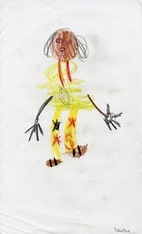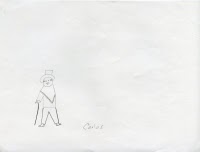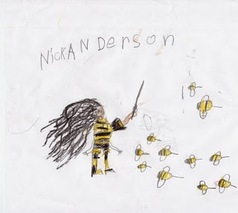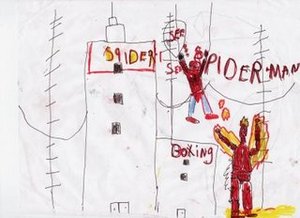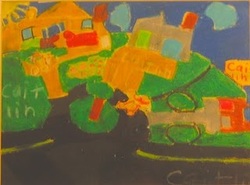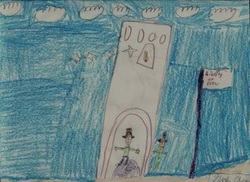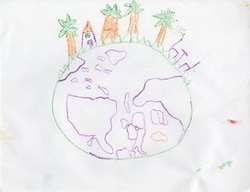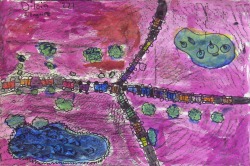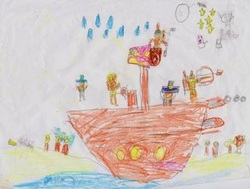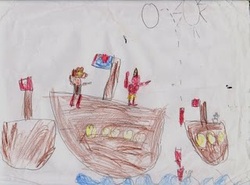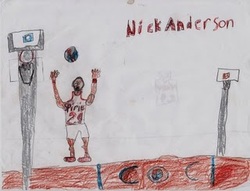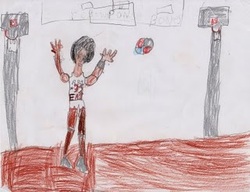The Schematic Stage: Achievement of a Form Concept
AGE: 7-9 YEARS
An increased "visual schema" and a strong narrative drive define the schematic stage (Lowenfeld) of artistic development. This stage is made possible by the creation of more recognizable human figures (addition of neck, to distinguish head from torso, and correctly placed appendages) and complex symbols and the formation of a baseline (and skyline). This tool prevents objects from floating in space; they are grounded by gravity.
Throughout narrative drawing, children gain an understanding of the difference between "me" and "my world." Their drawings begin with a simple diea in mind and develop increasingly as they gain a better awareness of their surrounding and are more able to logically reason through thing. During this period, themes and symbols often become more gender specific.
During Symbol Making (Kerlevage), a complex system develops to help children communicate visually. These changes affect figures, organization, color, composition, and themes. Children develop many graphic tools to help them translate the three-dimensional world onto paper.
Characteristics to look for:
Throughout narrative drawing, children gain an understanding of the difference between "me" and "my world." Their drawings begin with a simple diea in mind and develop increasingly as they gain a better awareness of their surrounding and are more able to logically reason through thing. During this period, themes and symbols often become more gender specific.
During Symbol Making (Kerlevage), a complex system develops to help children communicate visually. These changes affect figures, organization, color, composition, and themes. Children develop many graphic tools to help them translate the three-dimensional world onto paper.
Characteristics to look for:
|
|
1. Human figures have distinct head and torso
2. Improved visual organization
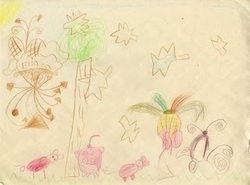
Eliana, 5 years
In this drawing, Eliana has assembled a complex cast of symbols. She uses a baseline of green grass to anchor the animals and plants on the page. The many symbols, including pigs, trees, fruit, and a sun, are drawn with realistic colors.
3. Color based on reality
|
Nick loves drawing various characters. In this image, he depicts a central figure with long black hair in a bee outfit. A swarm of bees surrounds the figure, ready to attack. The central figure's outstretched arm holds something in his hand (a wand?)
|
This is another example of Nick's characters. The focus in the drawing is on the figures. The bold colors are symbolic. Spiderman is dressed in his iconographic red suit. He is battling another figure in red whose arms are surrounded by yellow flames. The sparse environment includes two buildings and several tall telephone wires. Nick has also added a speech bubble to show what Spiderman is thinking/saying.
|
4. Symbols remain relatively unchanged
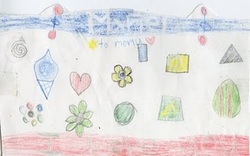
Mariel, Symbols, 6 years
Mariel made this drawing for her mom. She included various symbols, which remain relatively unchanged from earlier drawings. Triangles, squares, circles, hearts, and flowers are still of interest to the artist. THe flowers are made of more specific petals and are slightly more complex than earlier versions.
5. More attention given to spatial issues
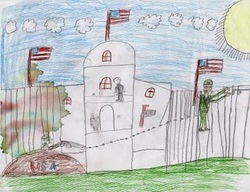
Nick, 6 years
In this complex action scene, Nick drew multiple baselines/levels to indicate various spaces. While a figure crouches behind a "USA" mound, another figure stands on a raised platform on the right side of the page. In this drawing, we can also see inside and outside the building. Inside, two figure are seen at various floors of the tower.
6. Children use graphic principles in order to translate the three-dimensional world onto paper
Personal Themes
|
Nick often draws similar themes over and over. Repeating scenes and stories helps Nick practice his drawing skills and help him build his visual vocabulary. In this series of battle scenes, big boats occupy large areas of the page. The drawings are also populated with people. The scenes are action-packed and include very specific boats and weapons.
|
These two drawings are from a series of drawings Nick did of famous basketball players. Each player is given specific facial features, hair styles, and jerseys. Each jersey has the team name and player's name on it. In each drawing, the players are grounded on a basketball court and are placed between two hoops. This helps to balance the pictures. Both players are also seen in action--either catching, shooting, or passing a basketball.
|
